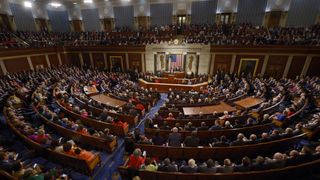Much is at stake in this November’s midterm elections in the United States: control of the US House of Representatives, the Senate and many state governorships and legislatures. But just as in Australian elections, the results will turn on a handful of marginal seat contests. Where are these key races? Who are the incumbents, the challengers and what are the issues in this small set of contests that will shape much of American politics – and policy – over the next two years and beyond?
House
Most congressional districts are safe, held securely by either the Democratic Party and the Republican Party (GOP). Control of the House of Representatives will be decided by contests in a few seats. Thirty seats are rated ‘toss ups’. These are competitive districts with margins of less than 10 per cent, that both parties have a good chance of winning.
115th House of Representatives

2018 midterms forecast
Seats that are likely to switch parties or are toss ups (R - 39, D - 3) are circled
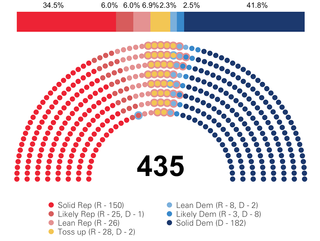
Unfortunately for Republicans, they currently hold 28 seats which are now extremely uncertain; only two marginal seats are currently held by Democrats. Seven seats that are leaning towards the Democrats are current GOP seats and three are likely to elect a Democrat. Given correct analysis and good data, projections suggest the Republican Party has an uphill battle in November.
Why are the toss-up seats special?
Marginal seats often determine who has control over Congress. Because the candidates in toss up congressional districts are neck and neck, it’s harder for analysts and political parties to determine who will win. There is an element of unpredictability that keeps observers on edge.
Toss up congressional districts
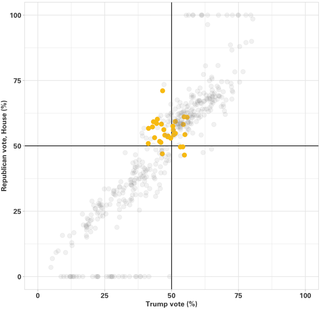
Toss up House races
|
District |
Representative |
Party |
Trump vote |
GOP vote (House) |
|
MN-01 |
Open |
D |
38.4 |
49.6 |
|
MN-08 |
Open |
D |
38.6 |
49.6 |
|
CO-06 |
Mike Coffman |
R |
41.3 |
50.9 |
|
MN-03 |
Erik Paulsen |
R |
41.4 |
56.7 |
|
CA-39 |
Open |
R |
42.9 |
57.2 |
|
IL-06 |
Peter Roskam |
R |
43.2 |
59.2 |
|
CA-25 |
Steve Knight |
R |
43.6 |
53.1 |
|
CA-45 |
Mimi Walters |
R |
44.4 |
58.6 |
|
WA-08 |
Open |
R |
44.7 |
60.2 |
|
CA-10 |
Jeff Denham |
R |
45.5 |
51.7 |
|
KS-03 |
Kevin Yoder |
R |
46 |
51.3 |
|
CA-48 |
Dana Rohrabacher |
R |
46.2 |
58.3 |
|
MN-02 |
Jason Lewis |
R |
46.5 |
47 |
|
TX-32 |
Pete Sessions |
R |
46.6 |
71.1 |
|
NJ-07 |
Leonard Lance |
R |
47.5 |
54.1 |
|
IA-03 |
David Young |
R |
48.5 |
53.4 |
|
VA-02 |
Scott Taylor |
R |
48.8 |
61.3 |
|
MI-11 |
Open |
R |
49.7 |
52.9 |
|
VA-07 |
David Brat |
R |
50.5 |
57.5 |
|
MI-08 |
Mike Bishop |
R |
50.6 |
56 |
|
NY-19 |
John Faso |
R |
50.8 |
54.2 |
|
OH-01 |
Steve Chabot |
R |
51.2 |
59.2 |
|
ME-02 |
Bruce Poliquin |
R |
51.4 |
54.8 |
|
NJ-03 |
Tom MacArthur |
R |
51.4 |
59.3 |
|
NC-09 |
Open |
R |
54.4 |
58.2 |
|
KY-06 |
Andy Barr |
R |
54.7 |
61.1 |
|
NY-22 |
Claudia Tenney |
R |
54.8 |
46.5 |
|
IL-12 |
Mike Bost |
R |
55 |
54.3 |
|
KS-02 |
Open |
R |
55.8 |
60.9 |
|
TX-07 |
John Culberson |
R |
67.5 |
56.2 |
Democrats need a net gain of 24 seats in November to take control of the House – and they are within reach. Historically, there has been strong pushback against the party in control of the White House, which bodes well for the Democrats.
Republicans have struggled to push their agenda through Congress due to their slim majority in the Senate. If the Democrats were to gain control over the House or the Senate, it would make that legislative process even more difficult.
One key challenge for Republicans is the number of incumbents who are retiring. Fourty-four Republicans have announced they are not seeking re-election in the midterms. Given that incumbents are often re-elected to office and the opposition typically surges in the midterms, Democrats have a better shot at taking extra seats and potentially control of the House.
House of Representatives majorities, 1950-2016
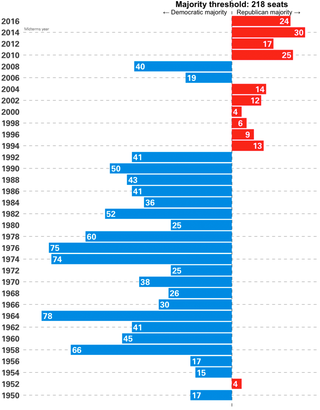
Democrats may be able to garner more votes than Republican candidates, but whether they can win in heavily gerrymandered districts is another question. In Pennsylvania, constitutional districts were redrawn after the state Supreme Court ruled previous maps unconstitutional. Of the three GOP congressional districts that are likely to turn Democratic in November, two – PA-05 and PA-06 – were drawn in March 2018 following the state’s Supreme Court ruling the previous map as a Republican partisan gerrymander. Under the old district boundaries, the vote margin for the 2016 election in Pennsylvania’s 5th district was D+2.3. The calculated vote margin jumps to D+28.2 under a fair map.
The geographic position of the district matters. Districts that are essentially Republican enclaves in the suburbs of large liberal cities have the potential to turn 'blue'. This includes Minnesota 01, Iowa 3rd (which encompasses Des Moines), and the 6th Congressional District in lllinois outside of Chicago.
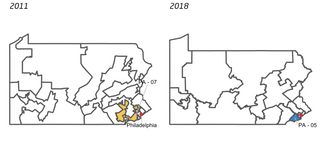
Senate
The Republican Party holds a slim 51 to 49 majority in the US Senate. This offers very little margin for the GOP’s more contentious legislation. It takes just two Republican Senators to vote with Democrats (which does happen) to stop bills from passing.
2018 midterms forecast
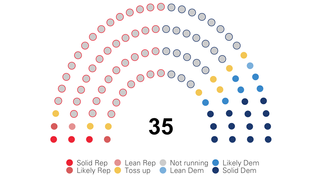
The Republican Party is less likely to lose seats in the Senate. Twenty-six seats currently occupied by Democrats are up for election, compared to nine GOP seats. Five Democratic seats are toss ups, whereas only three Republican seats are toss ups. However, this does not imply that Senate races are predictable – some of the most interesting campaigns will take place here.
Toss up Senate races
|
State |
Senator |
Party |
Trump vote |
GOP vote (House) |
|
AZ |
Open |
R |
Martha McSally |
Kyrsten Sinema |
|
FL |
Nelson |
D |
Rick Scott |
Bill Nelson |
|
IN |
Donnelly |
D |
Mike Braun |
Joe Donnelly |
|
MO |
McCaskill |
D |
Josh Hawley |
Claire McCaskill |
|
ND |
Heitkamp |
D |
Kevin Kramer |
Heidi Heitkamp |
|
NV |
Heller |
R |
Dean Heller |
Jacky Rosen |
|
TN |
Open |
R |
Martha Blackburn |
Phil Bredesen |
|
WV |
Manchin |
D |
Patrick Morrisey |
Joe Manchin |
Races to watch
Ted Cruz vs Beto O’Rourke
Democratic candidate Beto O’Rourke is a strong contender against Republican Senator Ted Cruz in Texas. O’Rourke’s campaign has been decidedly grass roots against the incumbent senator who has represented the state since 2013. Although Texas is a Republican stronghold, Hillary Clinton lost the state by the smallest margin since 1996. Progressive Democrats are rallying behind O’Rourke – he has raised double the money that Cruz has during the campaign – whereas Cruz recently enlisted the help of the Republican establishment and President Trump to drum up support.

The state is more urban and diverse than ever – Texas has a large Latino and African-American population – and if they turn out to vote, expect a very competitive race.
Rick Scott vs Bill Nelson
In Florida, Rick Scott is fighting to unseat Bill Nelson, the incumbent senator since 2001. The polls suggests that Scott has a slight lead over Nelson. One advantage for Scott is his deep pockets – he has spent US$27 million compared to Nelson’s US$6 million over the course of the campaign. Florida has always been a wild card; President Trump won the state by a meager 100,000 votes.
Claire McCaskill vs Josh Hawley
Claire McCaskill, Missouri’s Democratic senator, faces one of her toughest election cycles yet. Missouri supported Trump with 56 per cent of the vote. The newcomer to the national stage, Josh Hawley (Missouri’s attorney general), is currently neck and neck with McCaskill. Hawley is a Trump Republican and with the increasing swing towards Trumpian politics in Missouri, the outlook does not look good for McCaskill or the Democratic Party.
Gubernatorial elections
The gubernatorial elections are shaping up to be exciting midterm races to watch. Thirty-five states will be electing new governors this year, including Florida, Maine, Michigan and Alaska. Of the 26 seats held by the GOP, nine are toss ups or leaning Democratic. There are only nine Democrat-held seats up for election in 2018.
Governor races: 2018 midterms forecast
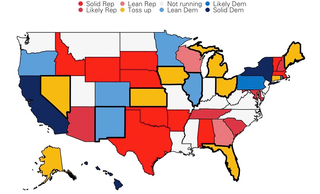
Races to watch
Florida
Florida’s gubenatorial election campaign wasn’t really in the national spotlight before the Florida primaries on 28 August. But with a staunch Trump supporter on the Republican side and a progressive Bernie Sanders-backed African-American candidate on the Democratic ticket, expect an unmissable showdown with ramifications for party direction in the 2020 presidential election. Andrew Gillum, mayor of Tallahassee, upset former congresswomen Gwen Graham (a centrist Democrat) to win the Democratic Party’s nomination. The GOP candidate decisively won with strong support from President Trump.


Alaska
Alaska’s race for governor is looking like a tight, three-way contest between the Independent centre-left incumbent Bill Walker, the Democratic candidate Mark Begich, and Republican Mike Dunleavy. There are predictions that the split votes between Walker and Begich will ensure a Republican win. They have until 4 September to combine tickets, or for one candidate to drop out; at the time of writing, both candidates were still officially on the ballot.





